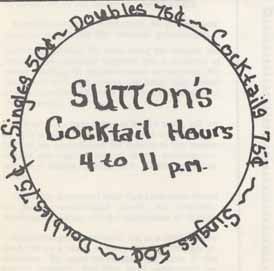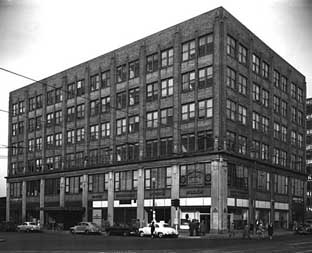Difference between revisions of "Sutton’s Place"
| Line 17: | Line 17: | ||
| − | Sutton’s began as a quiet neighborhood bar in the [[Sumner-Glenwood]] area of North Minneapolis. Like [[Kirmser's Bar]] in St. Paul, Sutton’s Bar was an unpretentious establishment owned by a heterosexual married couple. Harold and Elizabeth Sutton lived | + | Sutton’s began as a quiet neighborhood bar in the [[Sumner-Glenwood]] area of North Minneapolis.<small>(1)</small> Like [[Kirmser's Bar]] in St. Paul, Sutton’s Bar was an unpretentious establishment owned by a heterosexual married couple. Harold and Elizabeth Sutton lived nearby<small>(2)</small>—their neighborhood, like others in North Minneapolis, was home to predominantly working-class Jewish and African-American residents.<small>(3)</small> The area’s diversity likely provided a foundation to the queer-friendly atmosphere of Sutton’s in its early days. |
|} | |} | ||
| − | |||
| − | |||
| − | |||
{| {{prettytable}} | {| {{prettytable}} | ||
| Line 31: | Line 28: | ||
| − | The bar’s dramatic change came when Evelyn Sutton sold the bar to Ernest “Ernie” Pesis in 1966. Pesis, a former owner of the [[State Bar]] in the [[Gateway District]], was known to the queer community as a member of organized crime. With his brother, the crooked owner used Sutton’s solely for its considerable profit. | + | The bar’s dramatic change came when Evelyn Sutton sold the bar to Ernest “Ernie” Pesis in 1966.<small>(4)</small> Pesis, a former owner of the [[State Bar]] in the [[Gateway District]], was known to the queer community as a member of organized crime. With his brother Ron, the crooked owner used Sutton’s solely for its considerable profit.<small>(5)</small> |
| <div style="text-align: center;"> | | <div style="text-align: center;"> | ||
| Line 41: | Line 38: | ||
| − | Regardless of ownership, Sutton’s became an immensely popular site for “disco bunnies, | + | Regardless of ownership, Sutton’s became an immensely popular site for “disco bunnies,<small>(6)</small> or young gay men with a penchant for dancing. Sutton’s grew into other parts of the old bank as time progressed—even to the vaults<small>(7)</small>—and competed with the Gay 90s for a brief period. However, the club’s success didn’t offset Pesis’ questionable financial dealings—he eventually sold Sutton’s to “Andy” Anderson and John Moore, and they created [[The Saloon]]. |
| Line 47: | Line 44: | ||
| − | + | <small>(1)</small> According to an inventory of Minneapolis City Directories, in the 4th floor stacks of Hennepin County Central Library in Minneapolis. | |
| + | |||
| + | <small>(2)</small>''Ibid.'' | ||
| + | |||
| + | <small>(3)</small>Lewin, Rhoda. ''The Jewish Community of North Minneapolis.'' Chicago: Arcadia Publishing, 2001. | ||
| + | |||
| + | <small>(4)</small> City directories, ''Ibid.'' | ||
| + | |||
| + | <small>(5)</small> Carlyle, Erin. "Rommal Bennett's Trial Revisits Spate of Gay Murders in the Twin Cities." City Pages, 4/7/2009. http://www.citypages.com/2009-04-08/news/rommal-bennett-s-trial-revisits-spate-of-gay-murders-in-the-twin-cities/ | ||
| + | |||
| + | <small>(6)</small>Gronseth, Greg. Impromptu conversation with the author, Summer 2009. | ||
| + | |||
| + | <small>(7)</small>''Ibid.'' | ||
Part of [[Minneapolis/St. Paul, MN: 100 Queer Places in Minnesota History, (1860-1969), (1969-2010)]] | Part of [[Minneapolis/St. Paul, MN: 100 Queer Places in Minnesota History, (1860-1969), (1969-2010)]] | ||
Revision as of 22:07, 20 March 2010
Glenwood and Humboldt Ave N.; 5th and Marquette; 7th St. N. and 1st Ave. N., Minneapolis
| Sutton's Ad in the Uptown Voice, 1971. Courtesy of the Jean-Nickolaus Tretter Collection. |
Sutton’s Bar, also known as Sutton’s Place or simply as “Sutton’s,” was a curious meeting place for queer men (and women for a time) in Minneapolis. The establishment was one of few that operated before and after the landmark Stonewall Riots in New York, a national event that affected the Twin Cities’ queer community and their popular haunts.
|
| Sutton’s moved into the old Produce State Bank Building at 7th Street North and First Avenue North in the early 1960s. 20 years before gentrification, the rough area was home to vacating warehouses and cheap wholesalers. Harold and Elizabeth possibly saw business opportunity in the neighborhood, but they likely cared more about cheap rent.
|
The Produce State Bank building in 1959, approximately 10 years before Sutton's relocated to this site. Image Courtesy of the Minnesota Historical Society. |
Regardless of ownership, Sutton’s became an immensely popular site for “disco bunnies,(6) or young gay men with a penchant for dancing. Sutton’s grew into other parts of the old bank as time progressed—even to the vaults(7)—and competed with the Gay 90s for a brief period. However, the club’s success didn’t offset Pesis’ questionable financial dealings—he eventually sold Sutton’s to “Andy” Anderson and John Moore, and they created The Saloon.
(1) According to an inventory of Minneapolis City Directories, in the 4th floor stacks of Hennepin County Central Library in Minneapolis.
(2)Ibid.
(3)Lewin, Rhoda. The Jewish Community of North Minneapolis. Chicago: Arcadia Publishing, 2001.
(4) City directories, Ibid.
(5) Carlyle, Erin. "Rommal Bennett's Trial Revisits Spate of Gay Murders in the Twin Cities." City Pages, 4/7/2009. http://www.citypages.com/2009-04-08/news/rommal-bennett-s-trial-revisits-spate-of-gay-murders-in-the-twin-cities/
(6)Gronseth, Greg. Impromptu conversation with the author, Summer 2009.
(7)Ibid.
Part of Minneapolis/St. Paul, MN: 100 Queer Places in Minnesota History, (1860-1969), (1969-2010)

